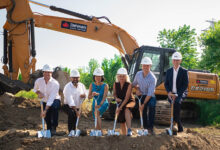Toronto’s tall towers are making the wind worse
What can mess up your hair, steal your hat and even knock you off your feet? Wind.
In Toronto, most powerful wind gusts — some which seem to stretch entire city blocks — have little to do with Mother Nature and more to do with the city’s skyscrapers.
The tall buildings shift the wind’s course, redirecting it to the ground where you get hit. We often dub these areas “wind tunnels” but an expert who studies this exact topic says what you’re feeling is “downwashing,” “channeling” or a “corner vortex.”
“When you have these very tall buildings all in one spot, there are multiple phenomena occurring at once,” said Haitham Aboshosha, an assistant professor of structural engineering at Ryerson University.
Aboshosha says this is why walking through the financial district can be unbearable at times.
Toronto has been building skyscrapers for much of the last century, but only within the last 20 years have city officials and other experts started looking at how a building’s design affects the environment at ground level.
Richard Anderson, who teaches geography at York University and has been studying Toronto’s environmental history, says when the city’s first tall buildings started going up there were accounts of people being knocked over and even severely injured by strong winds.
“When the TD Centre opened it was so notoriously windy that climbing ropes had to be used to help people up the stairs,” Anderson said.
CBC Toronto also found footage of similar ropes being used along Front Street to prevent people from getting blown away — footage you can see in the video above.
More buildings, more windy vortexes
Thankfully, climbing ropes are no longer the go-to solution. The subsonic wind tunnel that Aboshosha runs at Ryerson University tests how buildings interact with wind.
“We test to see if the building will change the wind patterns for people on the ground. We can suggest what to do to help them with [the building], we can alter the shape slightly to make it behave better,” said Aboshosha.
Here’s a description of the top three problems caused by tall buildings:
- Downwashing occurs when wind hits a building, slides down the facade, and spins out on the ground at high speeds.
- Channelling occurs when instead of having a large open pathway, wind is funneled through the space between two buildings, making it go faster.
- A corner vortex occurs when wind hits the corner of a building and a sharp edge causes it to speed up as it turns the corner.
Some easy solutions include adding a podium or awning to the building’s design, Aboshosha says. When the air strikes the top of the building and is forced downward, the podium will stop it before it hits the street and divert the wind upward.
There are rules in place to prevent problematic towers from going up but Lorna Day, director of urban design for the City of Toronto, says sometimes the changes needed to fix the wind issue can’t be made.
“Sometimes the information comes back to us too little too late and it’s difficult to go back and redesign the building,” said Day.
City updating its wind test rules
Most building proposals over 12 storeys need to have a wind assessment done. Day says the city is currently updating these regulations because they’re two decades old and Toronto’s definition of what it means to be comfortable on the ground is now very different.
“I think a lot of those definitions were based on a man standing in the wind, but have we really thought about what it’s like to be a child standing or sitting under those same spaces with those wind speeds,” said Day.
As cities continue to grow vertically, street level comfort is something more and more people are concerned about. In Toronto alone, there are nearly 400 buildings proposed.
“It’s a shared responsibility between the developer and the city to come up with some solutions. But before we can solve the problem, we have to understand it. So really right now it’s about defining the problem,” said Day.
A full update is expected in about a year.








Redes Sociais - Comentários